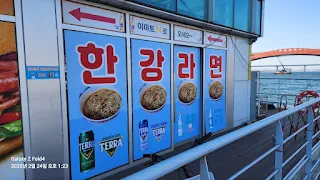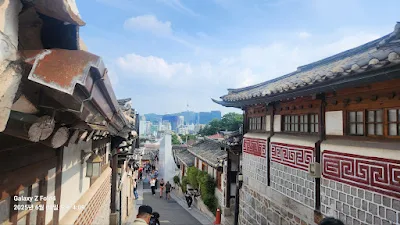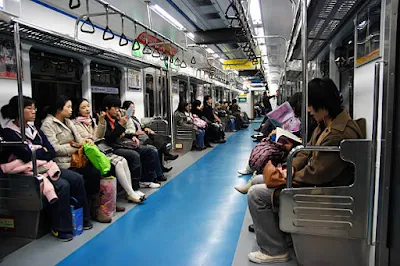Spring in Korea – The Beginning of a New Season Along the Han River
In countries that experience winter, the arrival of spring holds a special meaning. For those living in places with long winters, the excitement of spring is even greater. Korea, with its relatively long winter, welcomes spring with open arms. Living in Seoul, I find myself eagerly anticipating the season and often go on spring outings. Like other cities, Seoul experiences a transition as the harsh winter wind softens, and warmth begins to spread along the Han River. The sunlight reflecting off the river sparkles like jewels (I have taken some photos of this scenery), and the gentle breeze gradually melts away the cold air that lingered throughout winter. This is how spring arrives in Korea. When I walked along the Han River yesterday, the temperature was a comfortable 13°C. I'll share some pictures of the Han River scenery with you.
I am sharing photos taken during my walk along the Han River yesterday. Through these images, I hope you can experience Korea’s spring a little more closely.
1. The Beginning of Spring – Warm Sunshine and Exciting Changes
Spring in Korea is not just about the change of seasons; it symbolizes a fresh start. However, in the past, spring was often called the "season of hunger." Up until about 40 years ago, spring was a time when food scarcity was a major issue. As the grains stored over the winter ran out and the barley had yet to ripen, this period was known as ‘Bori Gogae’ (Barley Hump). The term “hump” refers to a difficult uphill climb, symbolizing the hardship of the season. During this time, people had to ration their remaining food while waiting for the next harvest. However, today, Korea enjoys a prosperous spring, and the season is now associated with joy and new beginnings.
Spring in Korea lasts from March to May. Early March can still be chilly in the mornings and evenings, but the warm afternoon sun gradually allows people to shed their winter coats. By April, cherry blossoms bloom in full force, painting the entire city pink. In May, greenery deepens, making it the perfect season for outdoor activities.
The average temperatures are 5–15°C in March, 10–20°C in April, and 15–25°C in May, gradually wrapping the body in gentle warmth. Spring in Korea is more than just a seasonal change; it signals a new beginning.
Along the Han River, new sprouts emerge, and birds chirp and engage in courtship rituals. I recorded a video capturing the sounds of birds singing—listen below to experience the sounds of spring firsthand.
2. A New Beginning – Stories That Unfold with Spring
🌱 School Starts – A Fresh Start in Korea
Spring holds special significance for students in Korea. Unlike many other countries, the new school year begins in March. As the school term starts, campuses and classrooms fill with fresh faces. Young children hold new textbooks in their small hands, and university students walk through campuses lined with cherry blossoms, making new friends. If there is a season that best represents a new beginning, it is surely spring.
🌾 The Start of Farming – Nature Awakens
In Korea’s rural areas, the arrival of spring marks the beginning of farming activities. As the ground thaws and spring rains moisten the earth, farmers prepare for the year’s harvest. The sight of rice paddies being filled with water and young seedlings being planted is a classic image of Korea’s traditional spring.
3. The Splendor of Spring – A Blooming Wonderland
As spring arrives, Korea transforms into a paradise of blooming flowers. The Han River, in particular, is one of the most breathtaking places to witness the beauty of the season.
🌸 Cherry Blossoms (Early to Mid-April) – Cherry blossoms bloom across the country, from Yeouido’s Yunjung-ro in Seoul to Gyeongju’s cherry blossom paths and the Jinhae Cherry Blossom Festival, marking the peak of spring.
🌼 Forsythia & Azaleas (Late March to Early April) – Golden forsythias brighten the paths of the Han River Park and Namsan, while pink azaleas spread warmth along mountain trails.
🌷 Tulips & Canola Flowers (April to May) – As spring deepens, Everland and Jeju’s canola flower fields burst into vibrant colors, creating picturesque landscapes.
Laying down a picnic mat at Han River Park and taking in the scent of flowers in the breeze brings a deep sense of happiness, allowing one to fully embrace the joys of spring.
4. May, the Queen of Seasons – Recommended Travel Time in Korea
May is often referred to as “the queen of seasons”, as it is one of the most beautiful times of the year in Korea. The greenery becomes lush, and the weather is pleasantly warm without being too hot, making it a perfect time for travel. If foreigners are considering visiting Korea, May is the most recommended month. The warm sunshine and gentle breeze create an ideal atmosphere to enjoy nature, and various flower festivals and outdoor activities are held during this period.
🌼 Must-Visit Spring Festivals in Seoul (May)
Seoul Rose Festival (Jungnang Stream, Mid-May) – A beautiful walkway lined with blooming roses, accompanied by cultural performances.
Seoul Nanje Traditional Music Festival (Jongno, Early May) – A festival showcasing Korea’s traditional music, held in a tranquil setting.
Hangang Space-out Competition (Hangang Park, May) – A unique event where participants simply relax and do nothing, enjoying the serene spring atmosphere of the Han River. I’d love to participate in this festival myself!
With stunning nature and exciting festivals, May is an ideal time to visit Korea. If you are planning a trip, be sure to experience these seasonal delights!
5. Experiencing Spring at the Han River
🌞 Taking a walk along the Han River under the warm spring sun, you can witness new life sprouting along the water’s edge. People enjoy picnics, cyclists ride along the breezy paths, and visitors sit on benches, sipping coffee and soaking in the tranquil scenery. The Han River is one of the best places to fully enjoy spring. Additionally, one of its advantages is its accessibility—several subway stations provide easy walking access to the river.
📌 Recommended Activities:
Enjoy cherry blossom viewing at Han River Park
Rent a bicycle and cycle along the Han River (Bicycles are available for rent at most parks for around $3.50 per hour)
Lay out a picnic mat and enjoy the river view and evening skyline with snacks like fried chicken, Korean instant noodles, and delivery food
🌸 Experience Korea’s Spring Through My Words
Spring in Korea is not just a change in seasons; it is a time to feel the preciousness of new beginnings and life itself. The warmth of the sun along the Han River, the blooming flowers on the streets, and the laughter of people make Korea’s spring even more special.
Especially, May is the most recommended season for foreigners visiting Korea. With its pleasant weather, this month offers a chance to fully enjoy Korea’s natural beauty and culture.
I hope you can experience Korea’s spring firsthand! If you cannot visit Korea in person, I hope my words allow you to feel the essence of Korea’s beautiful spring.

























































.jpg)

.jpg)
.jpg)
.jpg)






